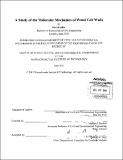A study of the molecular mechanics of wood cell walls
Author(s)
Adler, David, S.M. (David C.). Massachusetts Institute of Technology
DownloadFull printable version (10.12Mb)
Other Contributors
Massachusetts Institute of Technology. Department of Civil and Environmental Engineering.
Advisor
Markus J. Buehler.
Terms of use
Metadata
Show full item recordAbstract
Wood is the original structural material, developed by nature to support tall plants. Every advantageous feature of wood as used in artificial structures is rooted in the plant's evolved capability to withstand the conditions of its survival: specifically wind and gravity loads. Wood resists these load types with remarkable efficiency with performance comparable to structural alloys. Additionally, wood exhibits the ductility and energy dissipation capacity required of structural materials to prevent catastrophic failure. The hierarchical structure of wood allows for a wide range of mechanical properties; through the modulation of various parameters at various length scales, the living tree grows wood with properties fine-tuned to handle the specific loading conditions. This thesis explores why and how this hierarchical structure works, with a focus on the cell wall material of stiff fibrils in a pliant matrix. Here we report a simple coarsegrained model of the fibrils and matrix to provide a bottom-up description of the mechanics. We identify the mechanical behaviors for varying fibril angles, and in addition, for varying fibril lengths, plot force-strain relationships and compare the data with experimental results and theoretical predictions, providing insight into fundamental structure-property relations of wood. While it presents a simple formulation, it can successfully describe several key phenomena, specifically the three regimes of mechanical behavior: elastic, plastic, and high-strain stiffening, as well as the dependence of modulus on the fibril angle, and as such provides a bottom-up mechanistic approach to wood mechanics. Additionally, the intersection of biological inspiration, computer simulation, and three-dimensional printing is discussed highlighting profound implications for future advanced material design. Previous research developed computer simulations of theoretical biomimetic "bone-like" materials, which were then printed as samples for experimentation. A fractured sample is investigated with optical and electron microscopy with emphasis on failure mechanisms and the quality and resolution of the printing process. The observed damage patterns are shown to correlate to the deformation and failure patterns predicted by simulation, an impressive first step towards more advanced biomimetic fabricated materials designed through computer simulation.
Description
Thesis (S.M.)--Massachusetts Institute of Technology, Dept. of Civil and Environmental Engineering, 2013. Cataloged from PDF version of thesis. Includes bibliographical references (p. 55-59).
Date issued
2013Department
Massachusetts Institute of Technology. Department of Civil and Environmental EngineeringPublisher
Massachusetts Institute of Technology
Keywords
Civil and Environmental Engineering.